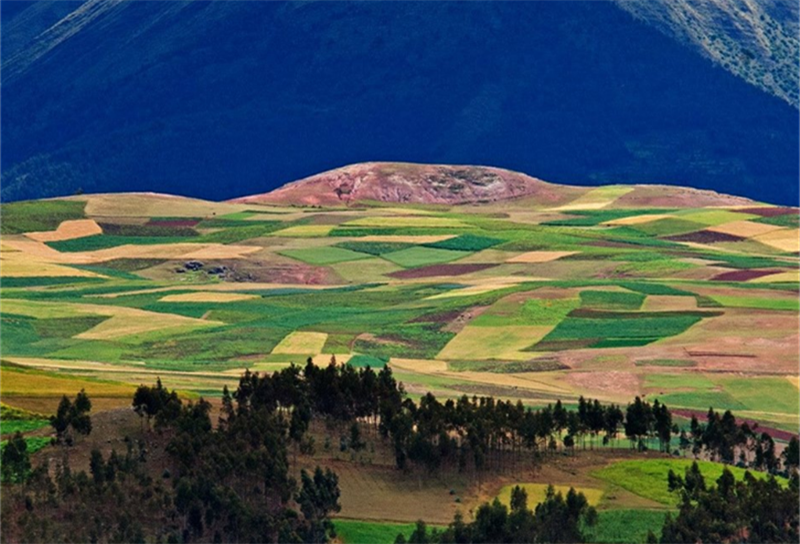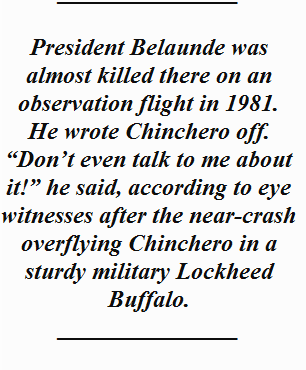
By Nicholas Asheshov
The dispute over a new attempt by the Lima and Cusco authorities to construct an unneeded, dangerous new airport overlooking Machu Picchu is getting noisy. It is, says John Hemming, the great Inca authority, as bad, he tells me, as Brexit in London, each side calling the other ‘ignorant,’ ‘stupid,’ ‘corrupt,’ even ‘blind.’
“Chinchero airport is a silly fantasy,” says Hemming, whose monumental “Conquest Of The Incas” is the authoritative account of the region.
From Lima, President Vizcarra financed a crew of bulldozers and trucks, sending them to the pampas of the Indian village community of Chinchero, where they have been digging holes since early in the year. These efforts are backed by no known plans and break a dozen regulations that prohibit building on or disturbing archaeological sites. The local community has not given the government the assent demanded by law. Simply put, the Cusco and Lima authorities are riding roughshod over well-established rules, regulations which aim to prevent exactly this kind of bullying destruction. Chinchero, a magnificent Inca and Colonial village atop a massif with a stunning view over the Machu Picchu heartland is to be, in effect, destroyed.
This week Vizcarra announced he had awarded contracts to a South Korean hodge-podge of companies to supervise the building of the airport. South Korea?
The Chinchero-Machu Picchu airport would replace Cusco’s present downtown airport. But the solution, to a problem that actually does not exist, is to modernize the present airport, at 3,200 m a.s.l., and build a much-needed proper highway up from the coast at Nazca. Much too simple, cheap and sensible.
The fight in Cusco and Lima over Chinchero today is a storm in an admittedly large teacup. The flurry will end in the same wastepaper basket, WPB, as other corruption-riddled projects. But not all end safely in the outhouse. Cusco has been a center of billions of dollars of government corruption, involving massive bribes for pathetic roads and hospitals, rubbish dumps, pipelines and sewage works involving ministries in Lima and proto-Cusco groups.
Chinchero is up in front with these, with upwards of $300m in start-up ante diverted from regional government funds for hospitals and schools, handed to obscurely identified community groups.
The Cusco regional governor, Jorge Acurio, who dished out the money for the purchase of Chinchero potato fields, has been in jail for the past couple of years on pending bribery charges relating to a fistful of projects. The mayor of Urubamba at the time, Benizio Rios, has begun a seven-year sentence for corruption (Chinchero lies within the province of Urubamba). He and Acurio were providing the official front for a group of Cusco and Lima businessmen and politicos pushing for this scruffy project. Vizcarra himself faced impeachment proceedings by the Congress in 2017, for his cloudy role as minister of Transport in Chinchero. President Kuczynski hurriedly issued him with a diplomatic passport, allowing him to slide out to Ottawa as ambassador.
 Destroying Chinchero almost doesn’t matter any more as the tourist industry, those pushing for this new airport, has a lousy track record. It has already destroyed much of the rest of the Inca heartland, starting with Chinchero’s Inca neighbor, the once-superb jewel of Olllantaytambo. The Cusco authorities have acknowledged a problem by declaring it in ’emergency.’ A few years ago Ollanta was a quiet, lovely ancient indian town. Today it is a collapsed, noisy, traffic-clogged maelstrom. Machu Picchu itself has become a daily misery of queues and confusion. The three most important sites within MP can no longer be visited beyond an incomprehensible lottery system. Thank the Lord I don’t have to go ever again.
Destroying Chinchero almost doesn’t matter any more as the tourist industry, those pushing for this new airport, has a lousy track record. It has already destroyed much of the rest of the Inca heartland, starting with Chinchero’s Inca neighbor, the once-superb jewel of Olllantaytambo. The Cusco authorities have acknowledged a problem by declaring it in ’emergency.’ A few years ago Ollanta was a quiet, lovely ancient indian town. Today it is a collapsed, noisy, traffic-clogged maelstrom. Machu Picchu itself has become a daily misery of queues and confusion. The three most important sites within MP can no longer be visited beyond an incomprehensible lottery system. Thank the Lord I don’t have to go ever again.
The definitive block, however, to the Chinchero bad dream is that the Chinchero pampas are much too high, and the weather too murderously blustery, icy, to build there. President Belaunde was almost killed there on an observation flight in 1981. He wrote Chinchero off. “Don’t even talk to me about it!” he said, according to eye witnesses after the near-crash overflying Chinchero in a sturdy military de Havilland Buffalo.*
At over 3,700 m.a.s.l. Chinchero would be, along with La Paz’s El Alto, the world’s highest commercial airport. But El Alto has wide open surroundings and is safe on a good day. Chinchero, on the other hand, is dominated by wind shear, hail, cloud. The Cordillera Urubamba’s 6,000m a.s.l. glaciers and snowpeaks rise above Chinchero a couple of miles to the north. The subsurface of the pampas is a Swiss cheese nightmare of limestone caverns and underground lakes. The sink holes of Inca-terraced Moray are on the edge of Chinchero. Peru’s military aviation people refuse to give Chinchero even a preliminary certification. The ministries and official offices in Lima possess thick dockets of notarised documents saying Chinchero is “impossible” and even ridiculous as a site for a commercial or even military airport.
So Chinchero, which would be the most dangerous, most murderous airport in the Andes will not happen.
Unless of course the political and banking groups that have their beady eyes on the present airport’s downtown 240 hectares as building land, pull new cards from their sleeves. At today’s prices in that part of Cusco, land is worth something. Call it $1,000/m2.
Use your own fingers to work it out.
*Correction: Our original story identified the Buffalo, wrongly, as Lockheed. Roy Scott writes us from Bariloche about the mistake. Mr Scott, an old friend of the Peruvian Times, writes: “The Buffalo aircraft that scared Belaunde was not built by Lockheed, rather by Canadian de Havilland, financed by Scotiabank and EDC in 1969.”






Fascinating article but what a dreadful plan let’s pray it never goes ahead-we want and need conservation and preservation not destruction!😡
The greedy hands of big corporations led by the pseudo-elite will stop at nothing if profit is foreseeable… Even though such an institution will employ a lot of locals and will ultimately improve the area’s GDP, the damage it will cause is just not worth it. I pray that the author of this article is right and this airport does not become reality.